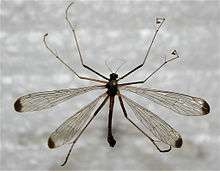Hangingfly
Bittacidae is a family of scorpionflies commonly called hangingflies or hanging scorpionflies.
| Hangingfly | |
|---|---|
 | |
| Hylobittacus apicalis, Michigan, USA | |
| Scientific classification | |
| Kingdom: | Animalia |
| Phylum: | Arthropoda |
| Class: | Insecta |
| Order: | Mecoptera |
| Infraorder: | Raptipeda |
| Family: | Bittacidae Handlirsch, 1906 |
| Genera | |
|
see text | |
| Diversity | |
| 16 genera, ca. 170 species | |
| Wikimedia Commons has media related to Hangingfly. |
The genus Bittacus, comprising approximately 75% of all species within the family, occurs worldwide. Other genera are mostly confined to South America or Australia. Members of this family may be confused with crane flies, in the order Diptera, but can be distinguished by their two pairs of wings and lack of halteres.
They are distinguished in the fact that during mating the male captures a prey insect and offers it to the female as a nuptial gift. The larger the prey item is, the more receptive the female will be to mating.[1]
The new species, Bittacus lepiduscretaceus sp. nov. from the mid-Cretaceous Myanmar amber, is the earliest fossil record of Bittacus and the first record of Bittacus species in the Cretaceous. It has new morphological characters to enhance our knowledge of early evolution of Bittacus hangingflies.[2]
Genera
This list is based on The World Checklist of extant Mecoptera Species.[3] Presumably complete up to 1997, it is updated as needed. The number of species in each genus are in parentheses. A number of extinct(†) genera have been described from the fossil record.
- Anabittacus (1) Kimmins, 1929 (Chile)
- Anomalobittacus (1) Kimmins, 1928 (South Africa)
- Apterobittacus (1) MacLachlan, 1893 (Southern USA)
- †Archebittacus (1) Riek, 1955 (Late Triassic, Australia)[4]
- Austrobittacus (1) Riek, 1954 (Australia)
- Bittacus (124) Latreille, 1805 (worldwide)
- Edriobittacus (1) Byers, 1974 (Australia)
- †Formosibittacus (1) Li, Ren & Shih, 2008 (Middle Jurassic, China)[5]
- Harpobittacus (12) Gerstaecker, 1885 (Australia)
- Hylobittacus (1) Byers, 1979 (USA, Mexico)
- Issikiella (5) Byers, 1972 (South America)
- †Juracimbrophlebia Wang et al. 2012 (Middle Jurassic, China)[6]
- †Jurahylobittacus (1) Li, Ren & Shih, 2008 (Middle Jurassic, China)[5]
- Kalobittacus (8) Esben-Petersen, 1914 (Central America)
- †Mongolbittacus (1) Petrulevicius, Huang & Ren, 2007[7]
- Nannobittacus (4) Esben-Petersen, 1927 (Brazil to Panama)
- Neobittacus (2) Esben-Petersen, 1914 (Brazil)
- Orobittacus Villegas & Byers, 1982 (California)
- Pazius (8) Navás, 1913 (Brazil to Panama)
- Symbittacus Byers, 1986 (Australia)
- Tytthobittacus Smithers, 1973 (Australia)
References
- Gao, Qionghua; Hua, Baozhen (3 December 2013). "Co-Evolution of the Mating Position and Male Genitalia in Insects: A Case Study of a Hangingfly". PLOS ONE. 8 (12): e80651. doi:10.1371/journal.pone.0080651. PMC 3849121. PMID 24312490.
- Li, Sheng; Zhang, Weiwei; Chungkun, Shih; Dong, Ren (September 2018). "A new species of hangingfly (Insecta: Mecoptera: Bittacidae) from the mid-Cretaceous Myanmar amber". Cretaceous Research. 89: 92–97. doi:10.1016/j.cretres.2018.03.005.
- "World Checklist of extant Mecoptera Species – Bittacidae (Hanging-flies)". California Academy of Sciences, Department of Entomology. 31 October 1997. Archived from the original on 2005-04-08.
- Kevin J. Lambkin (2017). "Archebittacus exilis Riek—the oldest hangingfly (Insecta: Mecoptera: Bittacidae)". Zootaxa. 4290 (2): 385–389. doi:10.11646/zootaxa.4290.2.10.
- Li, Y-L.; Ren, D.; Shih, C-K (2008). "Two Middle Jurassic hanging-flies (Insecta: Mecoptera: Bittacidae) from Northeast China" (PDF). Zootaxa. 1929: 38–46. doi:10.11646/zootaxa.1929.1.2. ISSN 1175-5334.
- Wang Y, Labandeira CC, Shih C, Ding Q, Wang C, Zhao Y, Ren D (2012). "Jurassic mimicry between a hangingfly and a ginkgo from China". Proc Natl Acad Sci U S A. 109 (50): 20514–20519. doi:10.1073/pnas.1205517109. PMC 3528590. PMID 23184994.
- Petrulevicius, J. F.; Huang, D-Y.; Ren, D. (2007). "A new hangingfly (Insecta: Mecoptera: Bittacidae) from the Middle Jurassic of Inner Mongolia, China" (PDF). African Invertebrates. 48 (1): 145–152.